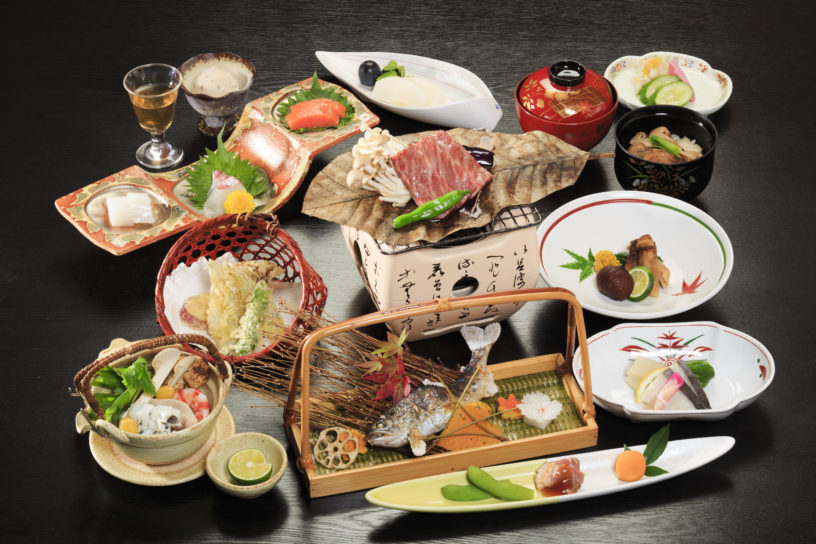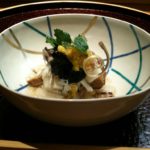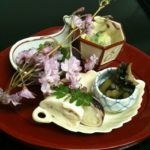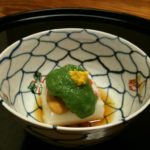What is Kaiseki?
Kaiseki (also known as kaiseki-ryori), is Japanese haute cuisine, and it consists of multiple courses that are artfully presented in small, eye-catching dishes. While some consider it adventurous eating, kaiseki emphasizes seasonal foods and simplicity of ingredients.
Because kaiseki originated with aristocracy and focuses on quality, it is often pricey. Luckily though, there are great options available for travelers on a budget. Wherever you choose to experience it, kaiseki is something every traveler should try because the meal captures the very essence of Japanese culture and history.
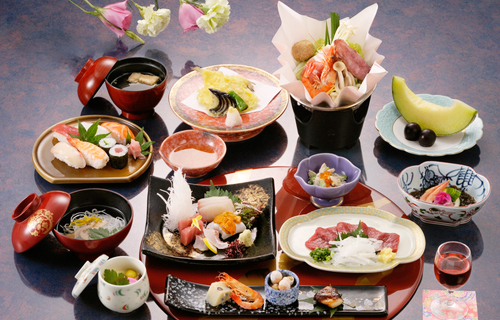
Where to Get the Best Kaiseki.
With that in mind, here are some of the most highly rated kaiseki restaurants (reflecting both traditional and contemporary styles) in three of Japan’s major cities:
Kyoto
Kyoto Gion-Nanba: This Michelin-starred spot is a well-known fixture of Kyoto’s geisha district in Gion and serves traditional Kyoto kaiseki (kyo-kaiseki). The quality is exquisite, the setting intimate, and despite being traditional, the presentation is extremely inventive. (And in my opinion, Kyoto Gion-Nanba is an absolute must-try if you’re in Kyoto.) Lunch starts at 5,000 Yen and dinner is about 15,000 Yen; dinner reservations required. (Address: 4-jo Hanamikoji Higashiiru, Higashiyama-ku, Kyoto, located near Yasaka Shrine; closest station is Gion-Shijo.)
Ishibekoji Kamikura: Popular kaiseki restaurant serving traditional dishes made with locally-sourced ingredients. Ishibekoji Kamikura has been in business for 30 years, and places added emphasis on presentation; serves dinner only, with prices starting at 15,000 Yen. (Address: 463-12 Shimokawaracho, Higashiyama-ku, Kyoto; closest station is Gion-Shijo.)
Kuzushi Kaiseki Nekoya: Small, exclusive spot that seats just 7 people. If you want to experience some of the best kaiseki in Japan served with a modern twist, this is the place to do it (and Kyoto is well-known for fabulous kaiseki). Dinner is about 1,500 Yen and lunch is 6,000 Yen; dinner reservations required. (Address: Tatsumae-cho 589, Kamigyo-ku, Kyoto; located near Nijo Castle.)

Osaka
Iroha: This restaurant serves consistently incredible kaiseki and has a Michelin star to prove it. The meals are a blend of traditional and modern, created by well-known Executive Chef Yoshimoto. Dinner only, with prices starting at 15,000 Yen. (Address: 1-3-19 Sonezakishinchi, Kita-ku, Osaka; located on the 5th floor of the Kitashinchi Building; closest station is Kitashinchi.)
Tokyo
Akasaka Kikunoi: This spot is (very) popular with locals (and diplomats – the restaurant is located in the ritzy embassy section of Minato, Tokyo). The Executive Chef and Owner, Yoshihiro Murata, is a second-generation kaiseki chef trained in both Japan and France, making him one of the best-known kaiseki chefs. The restaurant serves exquisite kyo-kaiseki in a traditional setting. Dinner starts at 1,500 Yen and lunch is about 6,500 Yen; dinner reservations required. (Address: 6 Chome 13-8 Akazaka, Minato-ku, Tokyo; closest station is Akasaka).
Rakushokushu Maru: For delicious modern kaiseki, this spot is a must-try. The kaiseki seems to be more of a fusion cuisine, but is still presented in the usual beautiful style. (And so far, this is my favorite kaiseki in Japan, as I tend to prefer contemporary takes on this cuisine (and this is one of the most budget-friendly kaiseki restaurants I have found!)). (Address: 5-50-8 Jingumae, Shibuya-ku, Tokyo; located on floor B1 of the Aoyama KT Building in the Omotesando area; closest station is Omotesando.)
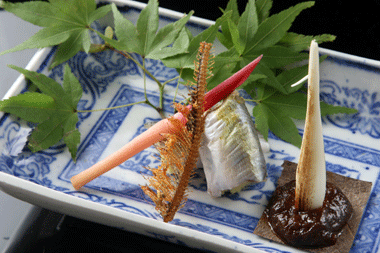
Budget-Friendly Kaiseki.
While kaiseki is often pricey, you can find low-cost spots to experience Japan’s traditional cuisine that won’t break the bank. Here’s how:
Hotels: Most Japanese hotels and even many western hotels serve kaiseki meals. Look for “Japanese breakfast” on the room service menu. This will be a kaiseki meal, presented in multiple dishes and featuring the typical kaiseki courses. In my experience, this is usually about 2,500 – 3,500 Yen, but of course it depends on your hotel.
Ryokan: Also known as Japanese-style inns (essentially Japanese B&B’s and a great way to experience local culture), ryokan are another budget-friendly way to experience kaiseki meals (typically at breakfast, which is included in your stay; some ryokan offer kaiseki for dinner as well, usually for a fee). One bonus of staying at a ryokan is that your kaiseki meal will be served to you in a more intimate setting than you’ll typically find in a restaurant.

Kaiseki is a Must-Try When in Japan.
Kaiseki is not only a great way to taste many delicious foods of Japan, it is also an incredible cultural experience. Because of this, travelers should check out this take on Japanese haute cuisine at least once. While restaurants can be pricey, hotels and ryokan offer more budget-friendly ways to try authentic kaiseki. Whichever way you choose to experience it, kaiseki will, without a doubt, be a memorable only-in-Japan experience.
For more info on kaiseki and how it’s made, check out The Art of Japanese Kaiseki.
Sources: Ishibe Kouji Kamikura , Kyoto Gion Nanba , Rakushokushu Maru

